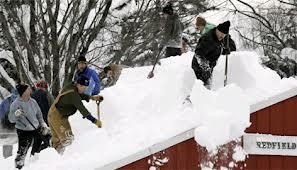
Today brings a forecast for warm weather and rain. A major concern is the combination of rain and snow load on roofs. Below is a message from Fire Chief Ken Clark:
The February 8th winter storm that hit Massachusetts presents a variety of challenges. As we approach the new week, it is anticipated that warm temperatures and rainfall may blanket portions of Massachusetts. With the recent heavy snowfall, rain will increase the weight of snow on roofs throughout the Commonwealth. Fire and building services need to plan for the onset of storm related issues.
Flat roofs, lower roofs that meet higher roofs, and areas with parapets or areas of drifting snow are major concerns. Many commercial building owners may hire or bring staff on to clear snow from flat roofs to help ease the burden of additional weight. In doing so, they will also make it easier for fire services to access and traverse these areas in the event of an emergency. In areas of significant snowfall consideration should be given to the additional weight firefighters may contribute on these roofs.
Homeowners, tenants, and businesses should be cognizant of the dangers posed by heavy snow loads on roofs, and the warning signs of potential structural weaknesses. In most instances, risks posed by accumulated snow on roofs may be mitigated by safely removing the snow from roofs of both commercial buildings and homes. As temperatures are expected to rise and fall over the next several days, every effort should be undertaken now to safely remove snow from roofs. Removing snow from rooftops will minimize the likelihood of structural collapse. Flat and low pitched roofs, most often found on industrial buildings, but are also used in certain home designs, are at the greatest risk of buckling under heavy snow and ice accumulations. Lower roofs, where snow drifts or accumulates from higher roofs are also vulnerable.
Tips for Homeowners in removing snow and ice from roofs and other areas
DO's
- Use a snow rake for pitched roofs (available at most hardware stores) to remove snow from your roof.
- Start from the edge and work your way into the roof.
- Try to shave the snow down to a 2 or 3 inches on the roof instead of scraping the roof clean, which will risk damage to your shingles or other roof covering.
- Keep in mind that any metal tool could conduct electricity if it touches a power line and metal tools may cause damage to the roof.
- Shovel snow from flat roofs throwing the snow over the side away from the building. Most plastic shovels are better, except for the ones with curved blades-those too will do some damage to your roof.
- Remove large icicles carefully if they're hanging over doorways and walkways. Consider knocking down icicles through windows using a broom stick.
- Wear protective headgear and goggles when performing any of these tasks.
- Consider hiring professionals to do the job. The combination of heights plus ice makes this one of the more dangerous house chores.
- If you don't hire professionals, at least have someone outside with you in case anything does go wrong.
- Keep gutters, and drains clean, free of ice and snow and keep downspouts clean at ground level.
- Make sure you smoke alarms and carbon monoxide detectors are working.
- Check your outside fuel (furnace) and dryer exhaust vents, making sure that they are not obstructed by snow or ice.
- Never use cooking equipment intended for outside use indoors as a heat source or cooking device. Never use your oven for heat.Clear snow away from furnace and dryer exhaust vents to prevent carbon monoxide poisoning.
- Space heaters need space, so use them in a 3-foot circle of safety; free of anything that catch fire. Space heaters are not designed to replace your central heating system; they are only designed to provide a little extra heat on a temporary basis. So be sure to turn them off when you leave room or go to bed at night.
- Clear snow away from downspouts so water has a place to go.
- Do not be tempted to use a heat gun or open flame torch to melt the ice; the risk of starting a fire is huge.
- If you feel you are in immediate danger, get outside and call 9-1-1.
- Use a snow rake for pitched roofs (available at most hardware stores) to remove snow from your roof.
- Start from the edge and work your way into the roof.
- Try to shave the snow down to a 2 or 3 inches on the roof instead of scraping the roof clean, which will risk damage to your shingles or other roof covering.
- Keep in mind that any metal tool could conduct electricity if it touches a power line.
- Shovel snow from flat roofs throwing the snow over the side away from the building.
- Most plastic shovels are better, except for the ones with curved blades-those too will do some damage to your roof.
- Remove large icicles carefully if they're hanging over doorways and walkways.
- Wear protective headgear and goggles when performing any of these tasks.
- Keep gutters, downspouts and drains clean.
- Sagging roof steel - visually deformed
- Severe roof leaks
- Cracked or split wood members
- Bends or ripples in metal supports
- Cracks in walls or masonry
- Cracks in welds of steel construction
- Sheared off screws from steel frames
- Sprinkler heads pushed down below ceiling tiles
- Water puddles where it never has before
- Doors that pop open
- Doors or windows that are difficult to open
- Bowed utility pipes or conduit attached at ceiling
- Creaking, cracking or popping sounds
- What to do if you have problems
- Call your local building or fire department.
- If there is imminent danger, evacuate the building and call 911.
Tips for Homeowners in removing snow and ice from roofs and other areas
DON'T's
Unless approved by a registered professional engineer,don't add your weight or the weight of equipment to the roof.
Don't use a ladder since ice tends to build up on both the rungs of the ladder and the soles of your boots.
Don't use electric heating devices like hair dryers or heat guns to remove snow and ice.
Don't use open-flame devices to remove snow and ice.
A cubic foot of dry snow weighs about seven pounds, while a cubic foot of wet snow may weigh up to 20 pounds; that's heavy. So, if possible, building owners should consider hiring someone to help with all of the snow clearing.
How to Recognize Problems with Roofs
Sagging roofs
Severe roof leaks
Cracked or split wood members
Bends or ripples in supports
Cracks in walls or masonry
Sheared off screws from steel frames
Sprinkler heads that have dropped down below ceiling tiles
Doors that pop open
Doors or windows that are difficult to open
Bowed utility pipes or conduit attached at ceiling
Creaking, cracking or popping sounds
Other Safety Tips for Homeowners
Tips for businesses in removing snow and ice from roofs and other areas.
DO's
The same tips apply. However, if you are going to use a snowblower, make sure that it has been approved by a structural engineer to be used on a roof, and that the blower is set to a high level above the roof so as not to damage roof membrane.
How to Recognize Problems with Roofs in Commercial Buildings
Many of the same apply from the residential section:
What other assistance is available?
Many fire departments have regional technical rescue teams available to local departments in case of collapse.
Massachusetts Task Force 1 is an Urban Search and Rescue Team in Beverly. The team is comprised of Police, Fire, EMS and Civilians who respond to major disasters under a contract with the Federal Emergency Management Agency (FEMA). Currently there are 150 people on the MATF-1 team.
Stay warm and stay safe!
Department of Public Safety & Department of Fire Services
P. Kenneth Clark
Chief of Department
Hopkinton Fire Department
Town of Hopkinton Emergency Management Director















